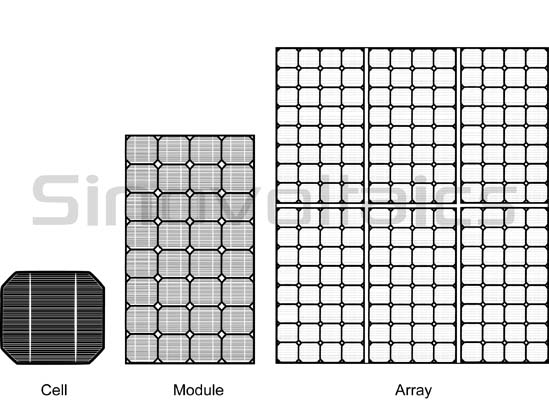Solar cells: how do they work?
A solar cell, also known as a photovoltaic cell (PV Cell), is a specialized diode, manufactured from a semi-conductor material, which converts sunlight into electrical energy.
Solar cell or photovoltaic (PV) cell
A solar cell, also known as a photovoltaic cell (PV Cell), is a specialized diode, manufactured from a semi-conductor material, which converts sunlight into electrical energy. The most commonly used semiconductor material is silicon; however certain other materials / elements have been developed and are used in manufacturing PV cells, such as Gallium Arsenide (GAAS) and thin films (CdTe).
Key components
Solar cells are the key component of every solar panel. A typical Si solar (Poly) has the dimensions of 156x156 and produces a power of 4.33W+. To increase the electrical energy output, multiple cells are connected together in series to form a solar panel (or solar module). These panels are then wired together, in parallel or series, to form a solar array.
 From Solar Cell to Solar Array
From Solar Cell to Solar Array
What is the composition of solar cells?
A typical PV Cell is made up of two or more layers of semiconductor material. One of the two layers contains positive electrons (P-Type) while the other contains negative electrons or holes (N-Type). The boundary separating the two layers is called a P-N Junction.
How do solar cells work?
Sunlight consists of very small particles, called photons. Photons could be visualized as small packets of solar energy. When these photons strike the PV Cells, a very interesting and unique phenomenon takes place: Upon striking the PV cells, some of the photons are reflected, while some are absorbed. When sufficient energy has been absorbed by the electrons (also known as threshold energy), they become free from their atomic bonding structure and migrate towards the positive layer, creating a voltage potential difference. If there is an external load connected to the PV cells, forming a closed electrical circuit, these electrons flow though it because of the voltage differential, creating electricity. This electricity could then be used to run electrical appliances or could be stored in battery banks for future use or during periods when there is no sunlight available (nights, cloudy days). The current produced by this process is DC (Direct Current) in nature. This could not be used to power most of the common household loads as these loads require the current to be AC (Alternating Current). In order to convert DC to AC, a solar inverter, is used.
